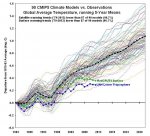- Joined
- Dec 22, 2012
- Messages
- 66,493
- Reaction score
- 22,157
- Location
- Portlandia
- Gender
- Male
- Political Leaning
- Libertarian - Right
Duh... No itsha Sherlock.They WILL cancel out if they are truly random no matter what you erroneously think. This is basic science. Go look it up before you make a fool of yourself and try telling me I am wrong.
Problem is there are significant systemic errors.
Not taking the time. I have known the models don't properly utilize the variables for a long time. I have sever sought out the specific misalignment, and that is an endeavor that would be massive. Since I am only an expert, and not a professional in this topic... I have better things to do with my time.How about YOU running the numbers. And for fun why don't you run the statistics of probability for Frank's insane error ranges so we might see which is more likely.
Are we suppose to believe a blog that doesn't say what you claim?I watched it twice then went a did a bunch of research on the subject. Not only did I find the Real Climate link Quaestio fond I also found another blog debate that Pat Frank participated in.
Where is comment 528, when the link says there are only 70 comments?
Your fellow believers never seek the facts, so I assume you think you can just claim anything you wish.
You are wrong because you believe what the alarmists say, rather than understanding that science is far from perfect. The hypothesis is busted when such information is shown. The correct formulation for models may never be seen in our lifetimes, but the correlations shown prove the modelling ideas share incorrect concepts, making the results incorrect.What he showed was high correlation between some of the models but not all of them. Some of the models overestimated clouds... some underestimated. Hence the plus or minus error Frank gave. From what I understand there should have been high correlation between all of them if there really was systemic error. And what ever you do... don't just tell me I am wrong. Tell me why I am wrong.
Science is meant to be tested and tested to try to break the hypothesis. Once broken, new ideas need to be formulated. As long as their models overestimate the effects of CO2, and underestimate other factors, they will never be right.

